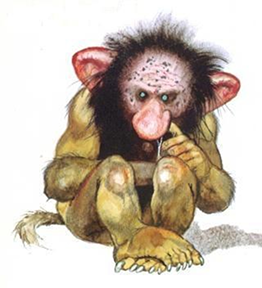 The unseen world, the world of giants, monsters, spirits and ghosts is an invaluable resource for writers of fiction. This article aims to encourage awareness of the literary traditions that exist, and the huge number of creatures from whom ideas can be derived. The underlying belief is that one will write better by studying the provenance of ideas and their past development. One can then build on what has been said before and extend and improve it in a logical way. Past history and present imagination will combine to increase dramatic effect. The first phenomena to be dealt with are Giants, Dwarves and Monsters.
The unseen world, the world of giants, monsters, spirits and ghosts is an invaluable resource for writers of fiction. This article aims to encourage awareness of the literary traditions that exist, and the huge number of creatures from whom ideas can be derived. The underlying belief is that one will write better by studying the provenance of ideas and their past development. One can then build on what has been said before and extend and improve it in a logical way. Past history and present imagination will combine to increase dramatic effect. The first phenomena to be dealt with are Giants, Dwarves and Monsters.
1. Giants
In writing about giants the writer has to recognize that they are in some sense real. Archeologists have dug up the remains of human or near-human creatures far bigger than present-day men. It has been suggested that they overlapped in time with Homo Sapiens and might even have interbred. (Early religious texts refer at times to the previous existence of giants). The principle of ‘regression upon the mean’ would then give us a steadily diminishing number of giants amongst us. We still have a few people of extreme stature and we use the word ‘giant’ about them. There is no accepted definition and we don’t have an exact height for Goliath of Gath. So there is uncertainty about how big giants might be or what they might be able to do. But they are normally much like us, but bigger and stronger. A good example is Fingal, the Scottish giant who contested with Finn McCool is a rock-throwing contest over the sea between Ireland and Scotland.
A primary function in literature is to provide an enemy against whom a human being can strive and win. In early societies there was a need for physical strength in a leader. Weapons were crude, and the strong man wielding a long sword or throwing a spear a great distance had an advantage. Such a leader became a role model, and his people strove to emulate his feats. Heredity was important, and being ‘the son of X’ (a great hero) gave status.
Naturally, the more strong and terrible the enemy, the more admiration gained by the hero who defeated him. So exaggeration crept in, and the enemy grew in stature with each re-telling, thus becoming a giant. This was much like the tall stories told by fishermen. Giants were necessary if the central character was to be a true hero. Geoffrey of Monmouth tells us in his History of the Kings of England that the only inhabitants of Britain when Brutus arrived from Troy were giants. Brutus had a deputy called Corinus who fought with and defeated the giant GogMagog. The strength of Corinus is described in one account like this:
“If he were to come up against a giant, he would overthrow him an easily as if he were fighting a mere boy.”
Corinus needed GogMagog. The principle applies in general terms, too. If you want to build up a character, build up his/her past achievements. Writers have been doing this for centuries. Baron Macaulay builds up Herminius in The Battle of Lake Regillus like this; “In his right hand the broadsword that kept the bridge so well, And on his head the crown he won when proud Fidaenae fell.”
Giants differ from human only in size and strength. This is because courage and strength are the qualities most needed by a hero and must be most heavily stressed. So magical powers are out – those belong to wizards, witchdoctors and spirits. Extra limbs and senses are out – those belong to monsters. So are non-human physical capabilities like being able to breathe fire – that belongs to dragons. So from one point of view giants are a little boring. On the other hand, their humanity means that they have emotions like us. These can be exploited. Giants can have illnesses and injuries. Giants can fall in love and win or lose a beloved woman. They can have peculiar personal habits, like gaudy clothing. They do not have to be enemies to human and can become good friends. They can be used to advertise products. (The Jolly Green Giant). Johnathan Swift gives a nice twist to the giant concept by setting Gulliver in the country of Lilliput, which is populated by dwarf people. Giants do not have to be especially intelligent – Goliath really should have known that a shepherd boy with a sling was a dangerous enemy. David had probably hit many wolves on the snout. Magic and trickery are often needed to overcome giants. Cornish folklore is rich in giants, including Jack the Giant Killer, who destroys four or five of them. (History of Jack the Giant Killer. 1771.)
2. Dwarves
A writer must be careful with dwarves, because they can be human, or members of a separate species. As human, they are the natural opposite of giants – the other extreme of the height distribution – but are regarded as less fortunate. Dwarfism is a recognized medical condition and historically some dwarfs have become famous, but we tend to avoid using the word for fear of giving offence, Dwarves as a separate species are well documented, and well-defined. They are short in stature, broad and hairy. They normally live underground, being skilled miners and capable of carving elaborate dwellings out of solid rock. They know all about sculpture and precious metals and jewelry. If they have to fight, their preferred weapon is the axe. They are not normally at enmity with humans – the Seven dwarves being very attached to Snow White. A writer can make good use of dwarves by tapping into their known adventures or extrapolating from them. They exist as The Nibelung in Norse mythology (and Wagners Ring Cycle) and have been well covered by Tolkien in The Lord of the Rings. Dwarves don’t seem to have much sexual life: we are often told whose father a dwarf was, but seldom his mother. The writer of a dwarf romance would be breaking new ground.
Like other fictional beings, dwarves take different forms and names and habits in different cultures. A legend from the north of England refers to The Dwarves of Simonside (Tyndale’s Legends and Folklore of Northumbria, 1930). These were not friendly to man and got their kicks from leading travellers astray after dark. They carried lighted torches to lead their prey into bogs. They gave up at dawn, but far from beings turned to stone as with Tolkien, they just disappeared until nightfall.
3. Monsters
Like dwarves, monsters can have a human origin or a wholly imaginary one. The derivation of the word, according to some sources, implies something going wrong in the human reproductive process. So we have gothic stories of some deformed creature born to an in-bred noble family and concealed in a dungeon. These are made more monstrous in literature by the secrecy that surrounds them. That is a useful point for writers, because access to the monster can be quite a story, as can the origin of the monster and the frightful consequences to be expected if he escapes. Physical description of the monster is very challenging because he has to be visibly monstrous, yet credible and not too offensive. As humans, we are uncomfortable about dwelling on aberrations of the human form. Monsters of this type are generally male. It is bad manners to create a female monster, though an evil woman can be described as one.
In some cases we don’t know for certain if we are dealing with a true monster or another species. Grendell, Beowulfs’ enemy, looks more like a giant, but when Beowulf has to track him to his lair and fight against his mother, we find that the two live together at the bottom of a lake – not a human habitat at all. Frankenstein’s creation, in Mary Shelley’s book, is always described as a Monster, but he was in fact assembled from various human body parts and had emotions understandable to humans. He was humanoid in appearance but monster-like in his behavior. He was unable to interbreed with humans, and at one time besought his maker to “Make another like me – a woman, so that I won’t be alone any more”. A great deal can be done with ‘the misfortunes of the monster’. There is a less well-known book called The Undying Monster (Jessie Douglas Kerruish) in which the creature is no monster but rather a werewolf. Dragons (to be dealt with elsewhere) are a class of their own, but is Lewis Carroll’s Jabberwock dragon or monster? The original illustration is ambiguous.
Other monsters are part human and part animal, usually because one of the Gods has been misbehaving sexually. Part of the offspring is then human and part represents the prime characteristic of the god. So we have the Centaur – part man and part horse (speed), and the Minotaur – part man and part bull (strength). There are a great many possible pairings, but a writer needs must be aware of things that have been done before. There were an awful lot of Greek Gods and most of them interfered with mortal women. So many God/Human beings have a track record of behavior. Making such a monster behave out of character is risky.
Trolls offer more imaginative freedom. They are not genetically linked to humans or to gods, though they do appear in early myths. They are sometimes represented as human except for a squashed-down aspect and very long hair. Tolkien’s trolls are definitely non-human in being turned permanently to stone if caught out after sunrise. Most civilizations have mythical beings of some type, such as The Tokoloshe of Xhosa folklore. Some are describable, but other are not so because seeing the creature means instant death.
True monsters, like trolls exist in myth and imagination, and new monsters can be created. James Thurber created The Todal – ‘an agent of the devil sent to punish evil-doers for doing less evil than they should’. But creation can be dangerous because if something is totally non-human the reader has no clue about its possible actions or behavior. Note that the extra-terrestrial in ET was ‘like us’ in many respects and could play a part in the story. This would not have been possible if he had just been a ball of gas. James Thurber never described The Todal in great detail ‘it looks like a blob of glup’ -, but he did give some facts about its behavior – ‘it smells like old unopened rooms and it makes a noise like rabbit screaming’.
His illustrator provides four legs under a dog-like body with the head upright and forward-looking, placed above the rump. The monster featured in The Kraken Wakes by John Wyndham is never described, but great attention is given to the devastation it causes. There is an interesting twist here, because Wyndham has taken an old myth from Scandinavia and changed the behavior of the monster. The original Kraken wound its tentacles round ships and pulled them to the bottom of the sea. Wynhams Kraken throws its tentacles onto land and clears the area of all life. As a general rule, the more detail given about a monster, the less frightening it is. One can begin to form strategies for defeating it. Without that information one can’t. In The Hunting of the Snark, Lewis Carroll does not describe its dangerous form – the Boojum – at all. It just has the capability to make people “Softly and silently vanish away”.
There are also unclassified creatures, notably Bigfoot and The Yeti, which may be real and may be imaginary. Unless we find out more about them a writer has complete freedom. Possibly they were left behind by accident when a party of alien explorers had to take off in a hurry.
History of the Kings of Britain. Geoffrey of Monmouth. 1136. Trans. in Penguin Books.
History of Jack the Giant Killer. Published Gasgow 1711. Not available but see the film.
Beowulf. Translation. Penguin. 1973
The Lord of the Rings. Tolkien 1954
Frankensteins Monster. Mary Shelley 1818. On Amazon.



